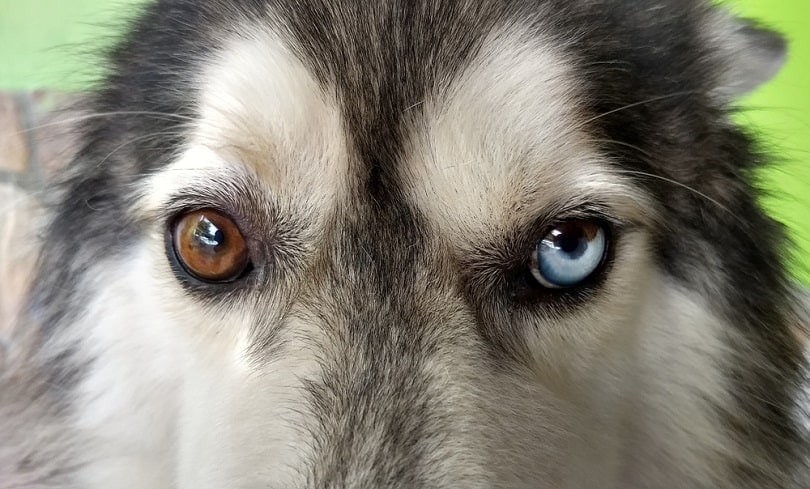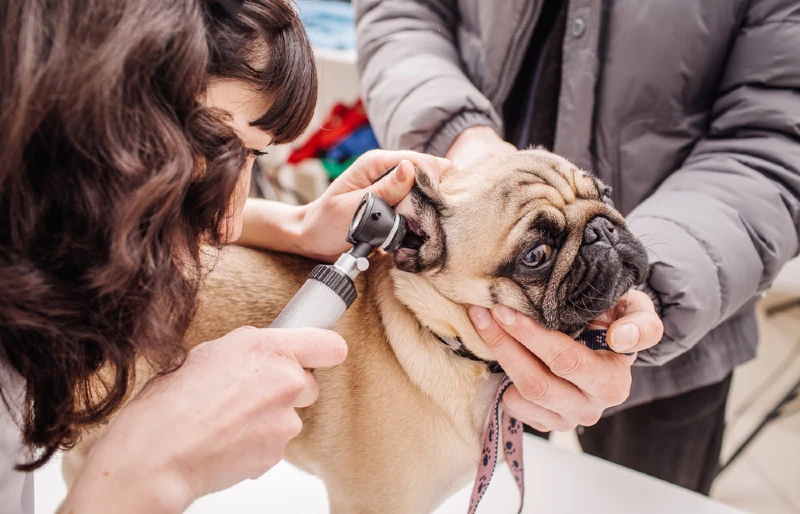Heterochromia in Dogs: Vet-Reviewed Facts, Causes & Concerns
Updated on

Click to Skip Ahead
Have you ever seen a dog or cat with two different colored eyes? This condition, also sometimes seen in humans, is known as heterochromia and occurs due to the different amounts of melanin pigment in the iris (the colored area in your dog’s eye). It’s a rather rare yet strikingly beautiful condition that may have you bewildered. What causes this anomaly?
Heterochromia in dogs is most often caused by a genetic mutation due to a lack of melanin. It is inherited and detectable starting in puppyhood. Read on to learn more about this condition, including what it means if your dog suddenly develops heterochromia as an adult.
What Is Heterochromia in Dogs?
Heterochromia is most often the result of a dog’s genetics, and it does not involve any vision impairment. This is known as hereditary heterochromia.
Another form of this condition (acquired heterochromia) can develop in adult dogs. This is not normal, however, and is usually the result of an illness or injury.
- Heterochromia iridum: This occurs when one eye is a different color than the other. Dogs with this type of heterochromia are also sometimes called “bi-eyed.”
- Heterochromia iridis or sectoral heterochromia: This happens when just part of the dog’s iris is blue while the rest remains a different color. This is sometimes known as partial heterochromia.
- Central Heterochromia: This occurs when the blue coloration radiates from the pupil, mixing with the other eye color in a spiky pattern.
What Are the Signs of Heterochromia in Dogs?

All dogs are born with blue or blue-grey eyes, but the color changes as they mature and heterochromia will be evident.
In cases of acquired heterochromia, the condition’s root cause will determine the signs. For example, if eye inflammation (uveitis) is causing your pup’s eye color change, you may notice other signs like red or swollen eyes, rubbing, scratching, flaky skin, eye discharge, and impaired vision.
What Are the Causes of Heterochromia in Dogs?
Heterochromia is caused by a lack of pigment (melanin) in one eye over another. This condition is often hereditary and is seen frequently in specific breeds. The lack of melanin will cause one eye to appear blue or bluish-white.
The color and pattern of a dog’s coat seem to influence how heterochromia appears in dogs. It’s typically seen in dogs with merle or piebald patterns. In Dalmatians, it seems to be more prevalent in females than males.
Though this condition is inherited, it can sometimes occur spontaneously as a result of eye issues, injuries, inflammatory diseases, or even medication. This is known as acquired heterochromia and should always prompt a visit to your vet. If your dog has normal eyes and suddenly develops this condition, you must consult your vet to rule out any potentially serious health conditions.
How Do I Care for a Dog With Heterochromia?

Dogs with inherited heterochromia do not require special care. Dogs with this feature do not have a higher prevalence of eye issues than those with eyes of just one color.
As previously mentioned, however, dogs with acquired heterochromia will need to be evaluated by their vet. Your pup may have an underlying health condition that needs addressing. Acquired heterochromia can result from an eye condition like uveitis or a clotting disorder. It may also occur due to neoplasia, an abnormal growth of body tissues or cells. If you notice any changes to your dog’s eye color or if its eyes seem to be causing pain, you’ll need to take it in for an eye examination.
Contrary to myth, dogs with blue eyes don’t have a higher prevalence of vision impairment, and most have healthy hearing. The exception to this rule is dogs with merle pattern. The merle gene has been associated with deafness and certain severe eye diseases, so affected dogs should be genetically tested if breeding is desired.
Frequently Asked Questions (FAQs)
What breeds are most commonly seen with heterochromia?
Do dogs with heterochromia cost more?
Sometimes. Breeders know dogs with heterochromia are highly sought after and can fetch them a higher price. Some will charge extra simply because of supply and demand.
Conclusion
Heterochromia is most often seen as a genetic mutation that produces dogs with two different colored eyes. The result is a beautiful, striking pup that turns heads wherever it goes. Dogs with the hereditary form of this condition are usually healthy and don’t require any special treatment.
However, adult dogs that spontaneously develop heterochromia may be suffering from an undiagnosed health condition.
Therefore, if your pup is suddenly sporting two different colored eyes, it’s best to make an appointment with your vet to have it evaluated.
Featured Image Credit: Enmanuel-Q, Shutterstock













